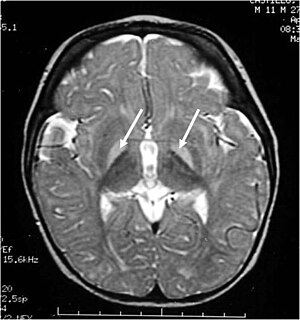Kernicterus
| Kernicterus | |
|---|---|
 |
|
| MRI of the head. Hyperintense basal ganglia lesions on T2-weighted images. | |
| Classification and external resources | |
| Specialty | pediatrics |
| ICD-10 | P57 |
| ICD-9-CM | 773.4, 774.7 |
| DiseasesDB | 7161 |
| MedlinePlus | 003243 |
| eMedicine | ped/1247 |
| Patient UK | Kernicterus |
| MeSH | D007647 |
Kernicterus is a bilirubin-induced brain dysfunction. Bilirubin is a naturally occurring substance in the body of humans and many other animals, but it is neurotoxic when its concentration in the blood is too high, a condition known as hyperbilirubinemia. Hyperbilirubinemia may cause bilirubin to accumulate in the grey matter of the central nervous system, potentially causing irreversible neurological damage. Depending on the level of exposure, the effects range from clinically unnoticeable to severe brain damage and even death.
When hyperbilirubinemia increases past a mild level, it leads to jaundice, raising the risk of progressing to kernicterus. When this happens in adults, it is usually because of liver problems. Newborns are especially vulnerable to hyperbilirubinemia-induced neurological damage, because in the earliest days of life, the young and still-developing liver is heavily exercised by the breakdown of fetal hemoglobin as it is replaced with adult hemoglobin. Mildly elevated serum bilirubin levels are common in newborns, and neonatal jaundice is not unusual, but bilirubin levels must be carefully monitored in case they start to climb, in which case more aggressive therapy is needed, usually via light therapy but sometimes even via exchange transfusion.
ABE is an acute state of elevated bilirubin in the central nervous system. Clinically, it encompasses a wide range of symptoms. These include lethargy, decreased feeding, hypotonia or hypertonia, a high-pitched cry, spasmodic torticollis, opisthotonus, setting sun sign, fever, seizures, and even death. If the bilirubin is not rapidly reduced, ABE quickly progresses to chronic bilirubin encepalopathy.
...
Wikipedia
